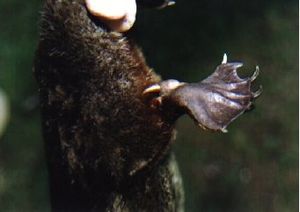- Platypus venom
-
The platypus is one of the few mammals to produce venom. Males have a pair of spurs on their hind limbs. The male's pair of spurs spits out a cocktail of poisons that, while excruciatingly painful, is not lethal to most animals.
Contents
Spur and crural gland
Venom is produced in the crural glands of the male, which are kidney-shaped alveolar glands located in the upper thigh connected by a thin-walled duct to a calcaneus spur on each hind limb. Female platypuses, in common with echidnas, have rudimentary spur buds which do not develop (dropping off before the end of their first year) and lack functional crural glands.[1] The spur is attached to a small bone which allows articulation; the spur can move at a right angle to the limb allowing a greater range of attack than a fixed spur would allow.[2] The spur normally lies flat against the limb but is raised when required.[3]
Venom
The crural gland produces a venom secretion containing at least nineteen different peptides, in addition to non-protein components.[4] Those peptides which have been sequenced and identified fall into three categories: defensin-like peptides (OvDLPs), C-type natriuretic peptides (OvCNPs), and nerve growth factor (OvNGF).[5] The different chemicals in the venom have a range of effects from lowering blood pressure to causing pain and increasing blood flow around the wound.[2] Coagulating effects have been seen during experiments on laboratory animals, but this has not been observed consistently. Unlike snake venom, there appears to be no necrotic component in the Platypus' venom - although some muscle wastage has been observed in cases of envenomation in humans, it is likely that this is due to the inability to use the limb while the effects of the venom persist.[3] It is unknown whether the pain caused is a result of the associated oedema around the wound or whether the venom has a component which acts directly on the pain receptors.
Although platypus venom has a broadly similar range of effects and is known to consist of a similar selection of substances to reptilian venom, it appears to have a different function from those poisons produced by non-mammalian species: its effects are not life threatening but nevertheless powerful enough to seriously impair the victim. It is not used as a method of disabling or killing prey, and although it acts as a defensive mechanism, only males produce venom. Since production rises during the breeding season it is theorized that it is used as an offensive weapon to assert dominance and control territory during this period.[2] Additionally, the genes involved in venom production in the two are, whilst related, distinct.[6] Hence, this appears to be an example of convergent evolution.[5]
A unique feature of the venom is the presence of a D-amino acid. This is the only known such example in mammalian systems.[7]
Effect on humans
Although powerful enough to kill smaller animals,[2] the venom is not lethal to humans. However, it produces excruciating pain which may be intense enough to incapacitate the victim. Swelling rapidly develops around the entry wound and gradually spreads outwards. Information obtained from case studies shows that the pain develops into a long-lasting hyperalgesia that can persist for months but usually lasts from a few days to a few weeks.[3][8] A clinical report from 1992 showed that the severe pain was persistent and did not respond to morphine. There have been no reported human fatalities.[3]
See also
Notes
- ^ J.R.Grant. "Fauna of Australia chap.16 vol.1b". Australian Biological Resources Study (ABRS). http://www.deh.gov.au/biodiversity/abrs/publications/fauna-of-australia/pubs/volume1b/16-ind.pdf#search=%22platypus%20pelt%201700%22. Retrieved 13 December 2006.
- ^ a b c d Gerritsen, Vivienne Baillie (2002-12). "Platypus poison". Protein Spotlight (29). http://www.expasy.org/spotlight/back_issues/sptlt029.shtml. Retrieved 13 December 2006.
- ^ a b c d "The venom of th platypus (Ornithorhynchus anatinus)". http://www.kingsnake.com/toxinology/old/mammals/platypus.html. Retrieved 13 December 2006.
- ^ G. M. de Plater, R. L. Martin, and P. J. Milburn (1995). "A pharmacological and biochemical investigation of the venom from the platypus (Ornithorhynchus anatinus)". Toxicon 33 (2): 157–169. doi:10.1016/0041-0101(94)00150-7. PMID 7597719.
- ^ a b C.M. Whittington, A. T. Papenfuss, and P. Bansal, et al. (2008). "Defensins and the convergent evolution of platypus and reptile venom genes". Genome Research 18 (6): 986–984. doi:10.1101/gr.7149808. PMC 2413166. PMID 18463304. http://www.pubmedcentral.nih.gov/articlerender.fcgi?tool=pmcentrez&artid=2413166.
- ^ Warren, WC., Hillier, LDW., Graves, JAM., et al (2008). "Genome analysis of the platypus reveals unique signatures of evolution". Nature 453 (7192): 175–U1. doi:10.1038/nature06936. PMC 2803040. PMID 18464734. http://www.pubmedcentral.nih.gov/articlerender.fcgi?tool=pmcentrez&artid=2803040.
- ^ Torres, AM et al; Menz, I; Alewood, PF; Bansal, P; Lahnstein, J; Gallagher, CH; Kuchel, PW (2002). "D-Amino acid residue in the C-type natriuretic peptide from the venom of the mammal, Ornithorhynchus anatinus, the Australian platypus". FEBS Lett 524 (1–3): 172–6. doi:10.1016/S0014-5793(02)03050-8. PMID 12135762.
- ^ G. M. de Plater, P. J. Milburn and R. L. Martin (2001-03-01). "Venom From the Platypus, Ornithorhynchus anatinus, Induces a Calcium-Dependent Current in Cultured Dorsal Root Ganglion Cells". Journal of Neurophysiology (American Physiological Society) 85 (3): 1340–1345. PMID 11248005. http://jn.physiology.org/cgi/reprint/85/3/1340.
Categories:- Vertebrate toxins
Wikimedia Foundation. 2010.

